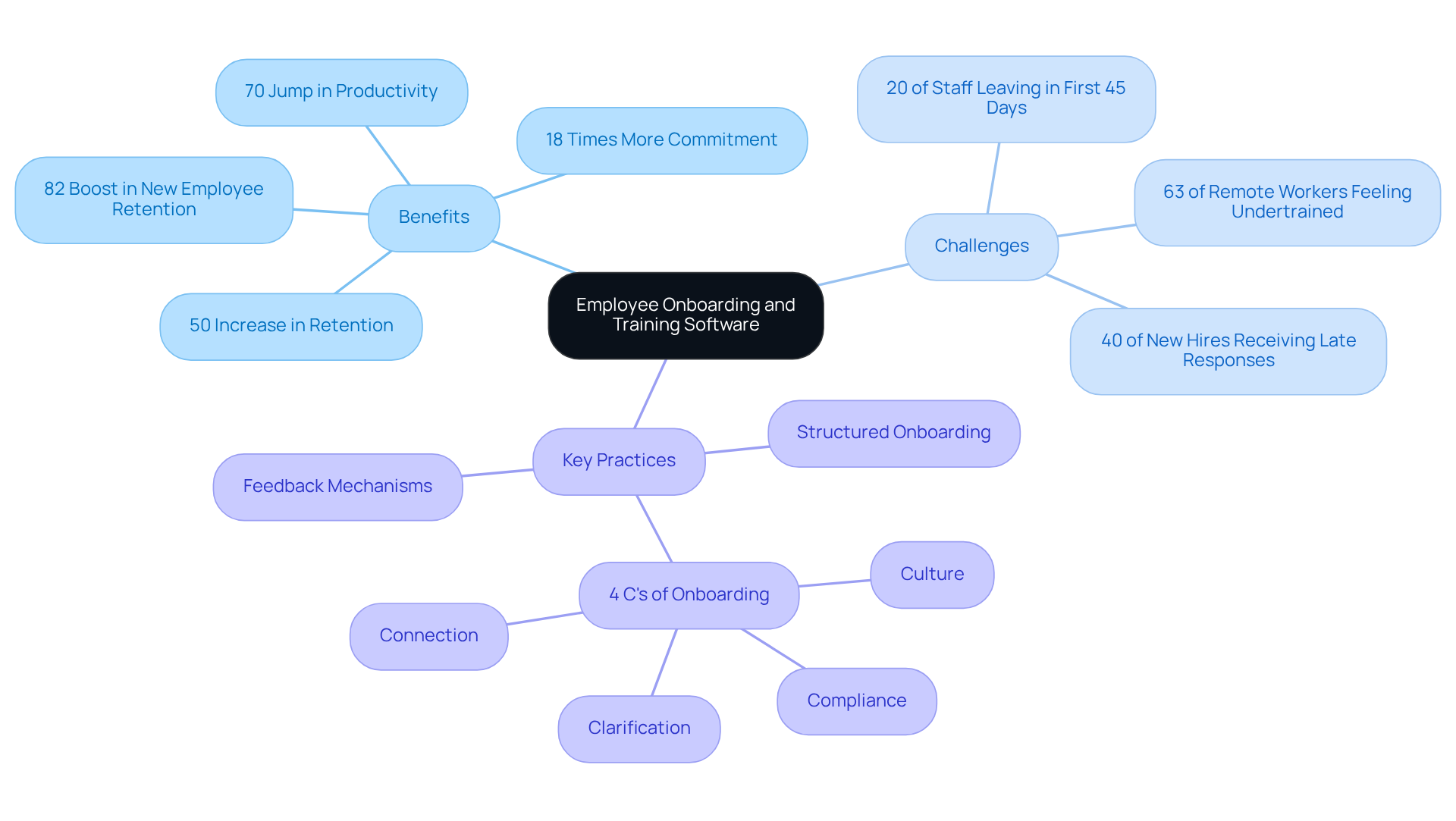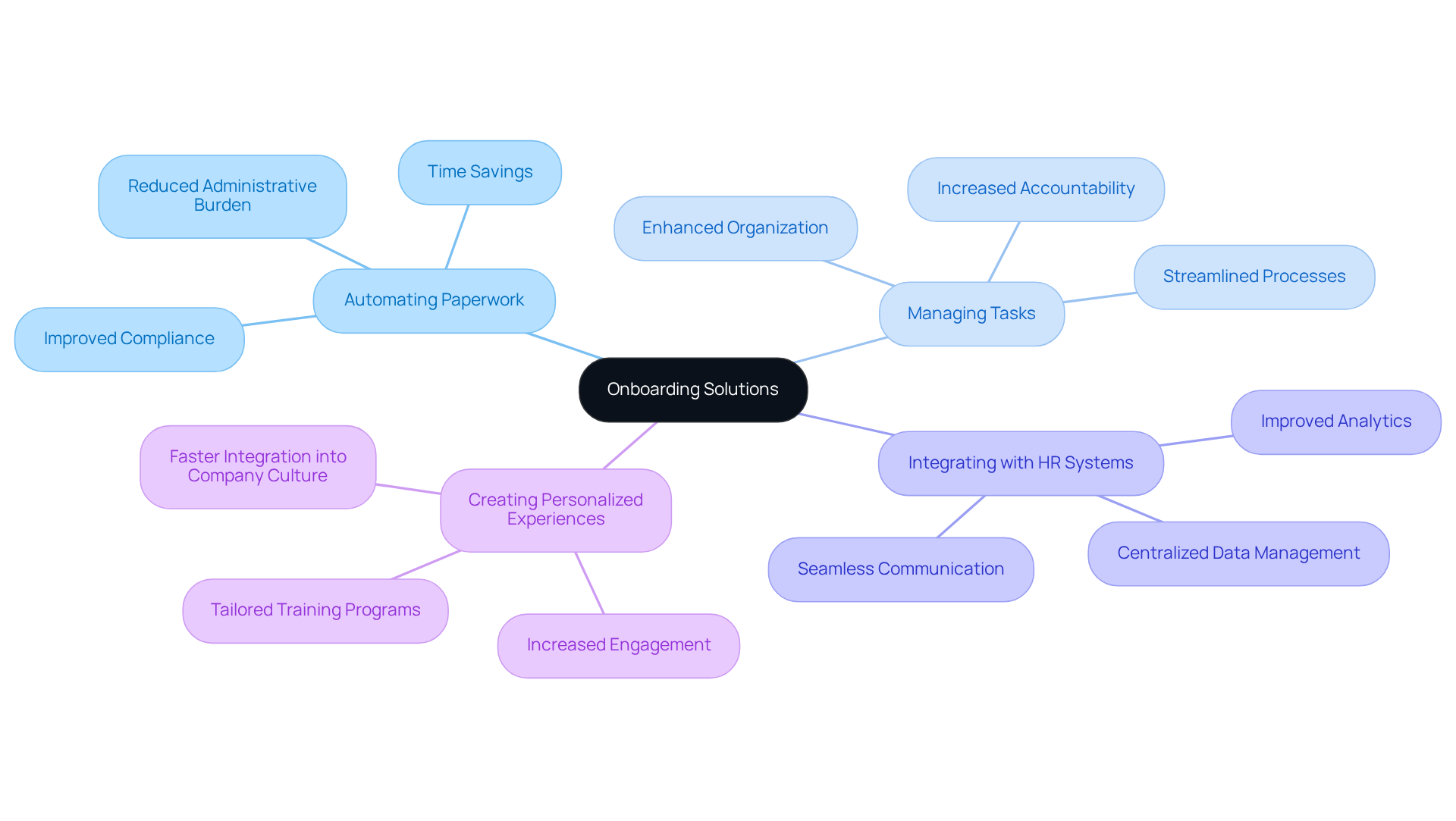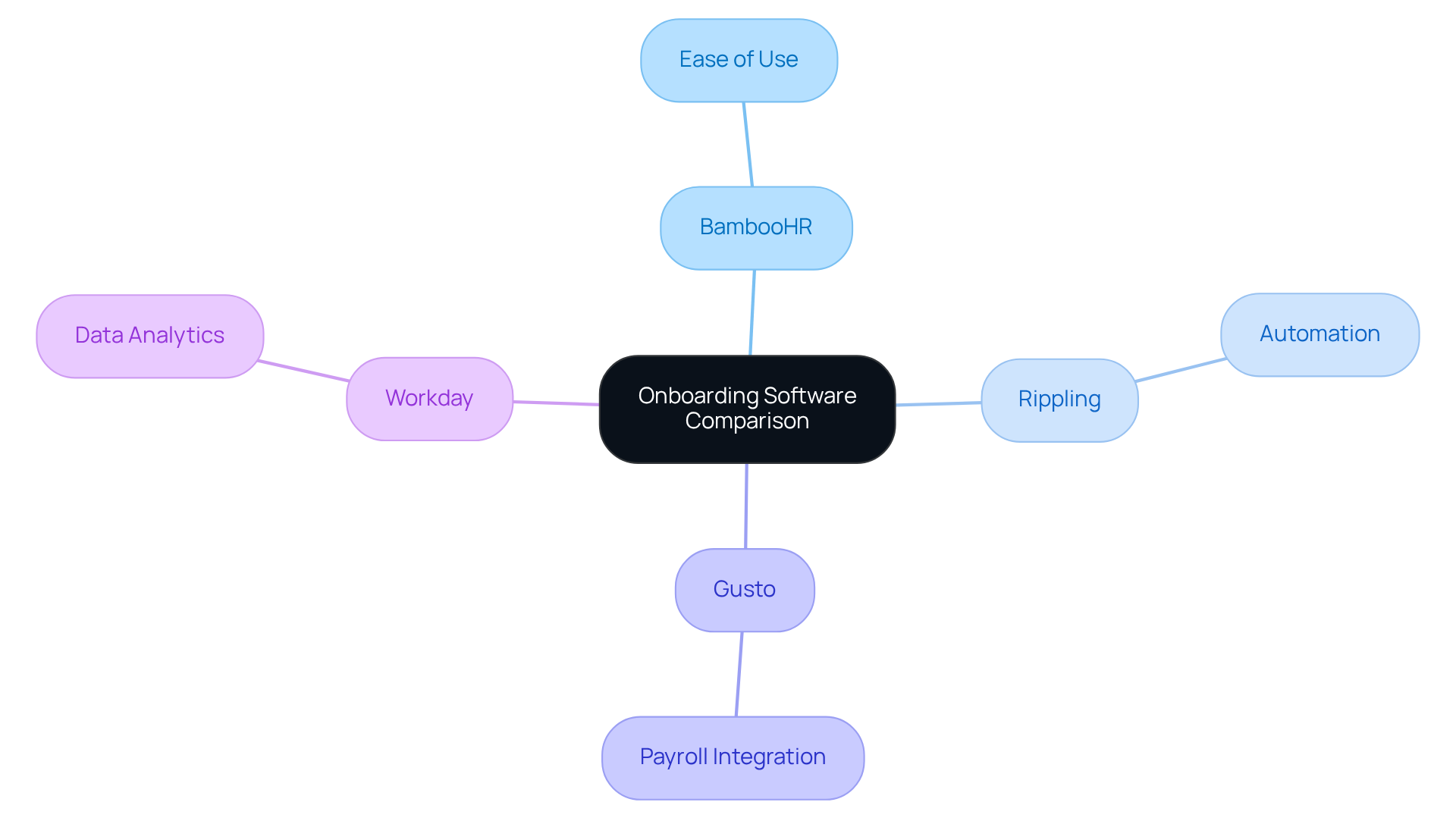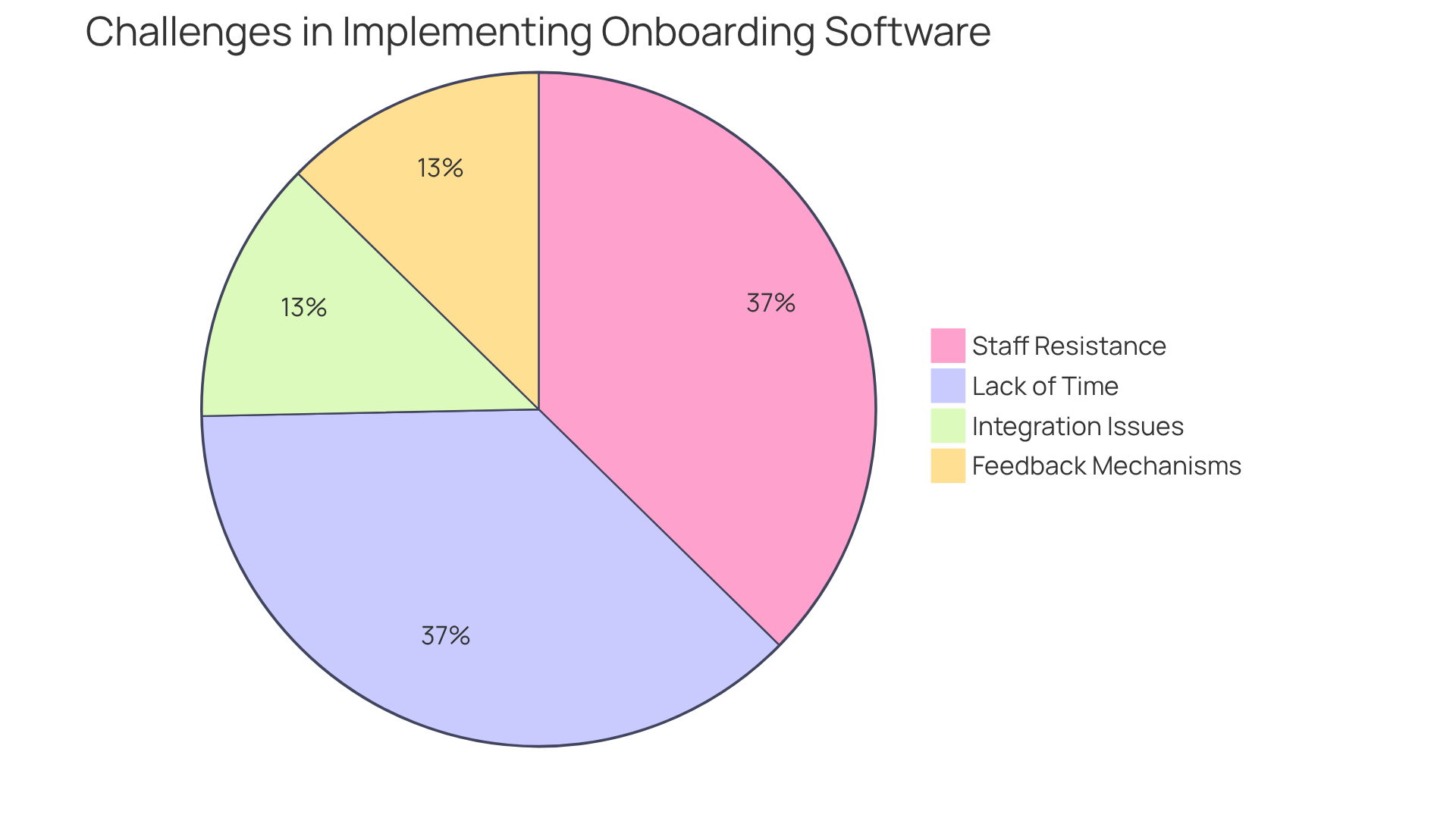
Remote Team Documentation Strategies
|
October 16, 2025
|
Comparative Analysis of Employee Onboarding and Training Software
Overview
You might be wondering about the effectiveness of employee onboarding and training software. Well, this article dives right into it, highlighting how these tools can significantly boost retention rates and productivity for new hires. Did you know that organized onboarding processes can lead to a whopping 50% increase in retention and a 70% boost in productivity? That’s pretty impressive, right?
Now, let’s talk about what makes onboarding successful. The article discusses the critical components, like the 4 C's, and emphasizes the need for improved training, especially for remote workers. It’s all about setting up new employees for success, ensuring they feel welcomed and equipped to thrive in their roles. So, if you’re looking to enhance your onboarding process, this is definitely worth a read!
Key Highlights:
- Employee onboarding and training software automates administrative tasks and helps new hires acclimate to company culture.
- Companies with organised onboarding processes experience a 50% increase in retention rates.
- Effective onboarding can lead to an 82% boost in new employee retention and a 70% increase in productivity.
- 20% of staff leave within the first 45 days due to poor orientation, highlighting the need for effective training methods.
- The 4 C's of onboarding—Compliance, Clarification, Culture, and Connexion—are essential for integrating new hires.
- 63% of remote workers feel their training during orientation is insufficient, indicating a need for improved induction procedures.
- Key features of onboarding solutions include automating paperwork, managing tasks, integrating with HR systems, and creating personalised experiences.
- Automation can reduce form completion time by up to 30%, and customised training can increase new employee productivity by 50%.
- Challenges in implementing onboarding software include staff resistance to change and integration with existing systems.
- Involving stakeholders in the software selection process and providing ongoing training can reduce resistance and enhance onboarding effectiveness.
- Only 20% of companies seek feedback on their onboarding processes, which is crucial for continuous improvement.
Introduction
You know, understanding the pivotal role of employee onboarding and training software is crucial for organizations that want to enhance their workforce integration. These innovative tools do more than just streamline administrative tasks; they help create a welcoming environment that aligns new hires with the company culture. This, in turn, boosts retention and productivity.
But here's a thought: with a staggering 20% of new employees leaving within their first 45 days due to inadequate onboarding, how can organizations effectively implement these systems to ensure a smooth transition for their new talent?
Let's dive into that!
Understanding Employee Onboarding and Training Software
You might be wondering how employee onboarding and training software truly makes a difference in welcoming new hires and enhancing their skills. Well, these tools are super important! They not only automate those pesky administrative tasks but also give new employees a glimpse into the company culture, helping them adjust smoothly. On the flip side, training software focuses on delivering educational content, tracking progress, and assessing performance. The impact of these tools on employee retention is pretty impressive; companies with organized orientation processes see a whopping 50% increase in retention rates. Plus can lead to an 82% boost in new employee retention and a 70% jump in productivity. Can you believe that new hires who go through a thorough orientation are 18 times more likely to feel committed to their organization? This really shows how crucial these systems are in fostering a supportive work environment.
Now, here’s something to think about: 20% of staff members leave within the first 45 days due to a poor orientation process. That's a big deal! It highlights the need for effective training methods. The 4 C's of onboarding—Compliance, Clarification, Culture, and Connection—are key to successfully integrating new hires. And let’s not forget about remote workers; 63% of them felt their training during orientation just wasn’t enough. This points to the urgent need for better induction procedures, especially when working remotely. Financially speaking, the stakes are high too—replacing a staff member can cost about 21% of their annual salary. As Neelie Verlinden puts it, "Employee orientation is critical in a new hire’s decision to stay with or leave a company." By ensuring employees feel welcomed and prepared to hit the ground running from day one, employee onboarding and training software significantly enhance job satisfaction and long-term engagement.

Key Features and Benefits of Onboarding Solutions
You might be wondering what makes for effective induction solutions, right? Well, key features of the employee onboarding and training software include:
- Automating paperwork
- Managing tasks
- Integrating with HR systems
- Creating personalized experiences for new hires
These features can really make a difference! For instance, they can save time on administrative tasks, boost new hire engagement, and help with a smoother transition into the company culture.
Imagine this: automation can cut down the time needed for form completion by up to 30%! And let’s not forget about customized training, which can lead to a whopping 50% increase in new employee productivity. Speaking of which, employee onboarding and training software often comes with analytics that help HR teams assess how well their induction processes are working. This means they can keep improving things over time. So, what do you think? Isn’t it exciting to explore how these solutions can transform the onboarding experience?

Comparative Analysis of Leading Onboarding Software
In 2025, you might be curious about which employee onboarding and training software applications are making waves in the market. Well, let’s take a look!
- BambooHR is getting a lot of love for its user-friendly interface and comprehensive HR features, making it a fantastic choice for small to mid-sized businesses.
- On the other hand, Rippling shines with its robust automation capabilities, which are super helpful for teams that are scaling up.
- Then there’s Gusto, known for its seamless payroll integration.
- Workday excels at providing a holistic view of employee data.
Each of these applications has its own unique strengths:
- BambooHR is all about ease of use.
- Rippling focuses on automation.
- Gusto nails payroll integration.
- Workday is your go-to for data analytics.
So, when you’re considering the right employee onboarding and training software for onboarding new employees, think about what your organization really needs—like team size, budget, and the specific features that will make your life easier. It’s all about finding the perfect fit for you!

Challenges in Implementing Onboarding Software Solutions
You might be wondering why introducing orientation tools can be so tricky, especially when it comes to staff resistance to change. Well, studies show that a good number of workers are hesitant to embrace new applications. Often, this reluctance stems from concerns about usability and how it might disrupt their established routines. For instance, did you know that 59% of HR professionals point to a lack of time as a major barrier to effective onboarding? This can really ramp up resistance when new systems come into play.
Now, let’s talk about integration with existing systems. Organizations often face challenges in making sure that new applications fit seamlessly into their current processes and culture. When there’s a misalignment, it can lead to frustration and disengagement among staff, especially if they feel the new program doesn’t meet their specific needs.
So, how can we tackle these challenges? It’s super important to involve stakeholders in the software selection process. When staff are brought in early, it helps them feel a sense of ownership, which can really reduce opposition. And let’s not forget about training! Staff need to feel confident using the new system to truly reap its benefits. That’s where SowFlow's employee onboarding and training software comes in handy—it allows organizations to create user guides easily, ensuring that training materials are relevant and accessible, which makes so much smoother.
Speaking of support, ongoing feedback mechanisms are key after implementation. Regular check-ins can help spot and resolve any issues that pop up, making the transition smoother and encouraging greater acceptance among employees. Alarmingly, only 20% of companies ask for feedback on their employee integration process. This really highlights how crucial feedback is for enhancing new hire experiences. By focusing on these strategies and leveraging employee onboarding and training software features from SowFlow, organizations can break down resistance to change and streamline their integration processes. Remember, can boost new hire retention by a whopping 82%! This shows just how effective documentation and training can lead to significant benefits for the organization.

Conclusion
You might be wondering how employee onboarding and training software can really make a difference for new hires. Well, these tools are crucial in shaping their experience and helping them feel at home in the workplace. By simplifying administrative tasks and creating a sense of belonging, they not only help keep employees around but also ramp up productivity. A well-structured onboarding process is key; it sets the stage for employee engagement and long-term commitment.
Throughout this article, we’ve highlighted some key insights, like the importance of the 4 C's of onboarding—Compliance, Clarification, Culture, and Connection. Plus, we took a closer look at some leading software options, such as BambooHR, Rippling, Gusto, and Workday, showcasing what makes each platform unique. We also touched on the challenges of implementation, like staff resistance and integration hiccups, which remind us why it’s essential to involve employees in the transition and offer solid training.
Ultimately, investing in effective onboarding and training software isn’t just about convenience; it’s a smart move that can really impact your organization’s success. By focusing on a comprehensive onboarding experience, companies can build a motivated workforce, cut down on turnover costs, and boost overall productivity. Embracing these solutions is vital for creating a supportive and engaging work environment that benefits everyone involved.
Frequently Asked Questions
What is the purpose of employee onboarding and training software?
Employee onboarding and training software automates administrative tasks, provides insights into company culture, and helps new hires adjust smoothly while delivering educational content, tracking progress, and assessing performance.
How does effective onboarding impact employee retention?
Companies with organized orientation processes experience a 50% increase in retention rates, while effective onboarding can lead to an 82% boost in new employee retention and a 70% increase in productivity.
What are the 4 C's of onboarding?
The 4 C's of onboarding are Compliance, Clarification, Culture, and Connection, which are essential for successfully integrating new hires into the organization.
What percentage of staff members leave within the first 45 days due to poor orientation?
20% of staff members leave within the first 45 days due to a poor orientation process.
How do remote workers feel about their training during orientation?
63% of remote workers felt that their training during orientation was insufficient, indicating a need for improved induction procedures for remote employees.
What are the financial implications of employee turnover?
Replacing a staff member can cost about 21% of their annual salary, highlighting the financial stakes of effective onboarding and training.
How does thorough orientation affect new hires' commitment to the organization?
New hires who go through a thorough orientation are 18 times more likely to feel committed to their organization.
👍
What others are liking
5 Steps to outline your ideal documentation structure
5 MINS READ
Where to start the your journey of mapping out your ideal documentation structure, aligning it with the very heartbeat of your organization?
Defining a winning level of detail in your process
3 MINS READ
What is too much detail, and what is too little? This article described in that winning level detail about what detail is enough.





